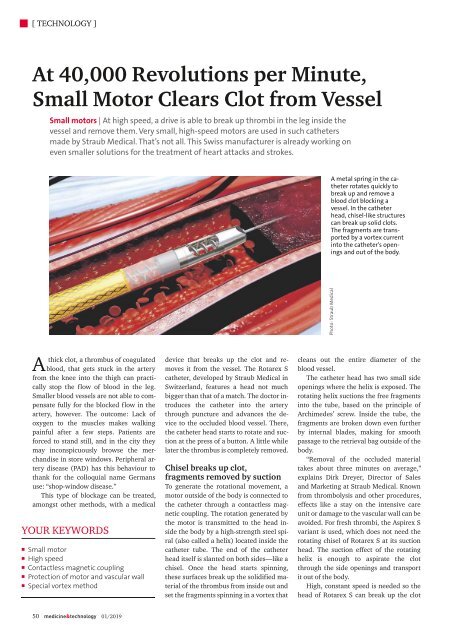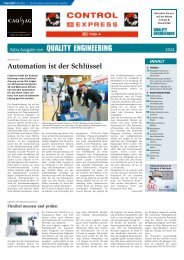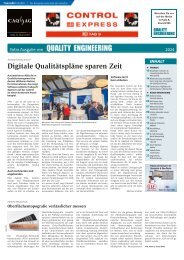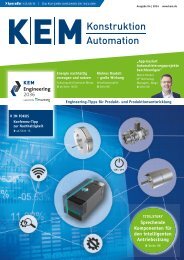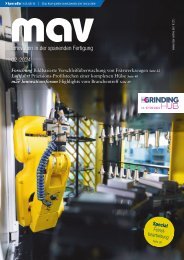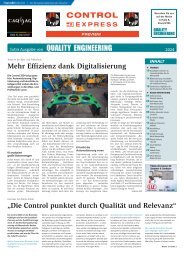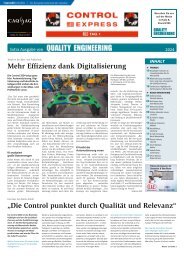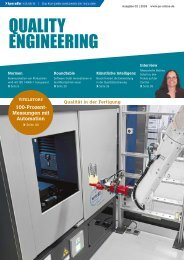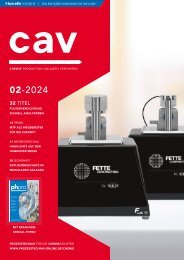medicine&technology 01.2019
You also want an ePaper? Increase the reach of your titles
YUMPU automatically turns print PDFs into web optimized ePapers that Google loves.
■ [ TECHNOLOGY ]<br />
At 40,000 Revolutions per Minute,<br />
Small Motor Clears Clot from Vessel<br />
Small motors | At high speed, a drive is able to break up thrombi in the leg inside the<br />
vessel and remove them. Very small, high-speed motors are used in such catheters<br />
made by Straub Medical. That’s not all. This Swiss manufacturer is already working on<br />
even smaller solutions for the treatment of heart attacks and strokes.<br />
A metal spring in the catheter<br />
rotates quickly to<br />
break up and remove a<br />
blood clot blocking a<br />
vessel. In the catheter<br />
head, chisel-like structures<br />
can break up solid clots.<br />
The fragments are transported<br />
by a vortex current<br />
into the catheter’s openings<br />
and out of the body.<br />
Photo: Straub Medical<br />
A<br />
thick clot, a thrombus of coagulated<br />
blood, that gets stuck in the artery<br />
from the knee into the thigh can practically<br />
stop the flow of blood in the leg.<br />
Smaller blood vessels are not able to compensate<br />
fully for the blocked flow in the<br />
artery, however. The outcome: Lack of<br />
oxygen to the muscles makes walking<br />
painful after a few steps. Patients are<br />
forced to stand still, and in the city they<br />
may inconspicuously browse the merchandise<br />
in store windows. Peripheral artery<br />
disease (PAD) has this behaviour to<br />
thank for the colloquial name Germans<br />
use: “shop-window disease.”<br />
This type of blockage can be treated,<br />
amongst other methods, with a medical<br />
YOUR KEYWORDS<br />
■<br />
■<br />
■<br />
■<br />
■<br />
Small motor<br />
High speed<br />
Contactless magnetic coupling<br />
Protection of motor and vascular wall<br />
Special vortex method<br />
device that breaks up the clot and removes<br />
it from the vessel. The Rotarex S<br />
catheter, developed by Straub Medical in<br />
Switzerland, features a head not much<br />
bigger than that of a match. The doctor introduces<br />
the catheter into the artery<br />
through puncture and advances the device<br />
to the occluded blood vessel. There,<br />
the catheter head starts to rotate and suction<br />
at the press of a button. A little while<br />
later the thrombus is completely removed.<br />
Chisel breaks up clot,<br />
fragments removed by suction<br />
To generate the rotational movement, a<br />
motor outside of the body is connected to<br />
the catheter through a contactless magnetic<br />
coupling. The rotation generated by<br />
the motor is transmitted to the head inside<br />
the body by a high-strength steel spiral<br />
(also called a helix) located inside the<br />
catheter tube. The end of the catheter<br />
head itself is slanted on both sides—like a<br />
chisel. Once the head starts spinning,<br />
these surfaces break up the solidified material<br />
of the thrombus from inside out and<br />
set the fragments spinning in a vortex that<br />
cleans out the entire diameter of the<br />
blood vessel.<br />
The catheter head has two small side<br />
openings where the helix is exposed. The<br />
rotating helix suctions the free fragments<br />
into the tube, based on the principle of<br />
Archimedes’ screw. Inside the tube, the<br />
fragments are broken down even further<br />
by internal blades, making for smooth<br />
passage to the retrieval bag outside of the<br />
body.<br />
“Removal of the occluded material<br />
takes about three minutes on average,”<br />
explains Dirk Dreyer, Director of Sales<br />
and Marketing at Straub Medical. Known<br />
from thrombolysis and other procedures,<br />
effects like a stay on the intensive care<br />
unit or damage to the vascular wall can be<br />
avoided. For fresh thrombi, the Aspirex S<br />
variant is used, which does not need the<br />
rotating chisel of Rotarex S at its suction<br />
head. The suction effect of the rotating<br />
helix is enough to aspirate the clot<br />
through the side openings and transport<br />
it out of the body.<br />
High, constant speed is needed so the<br />
head of Rotarex S can break up the clot<br />
50 medicine&<strong>technology</strong> 01/2019


